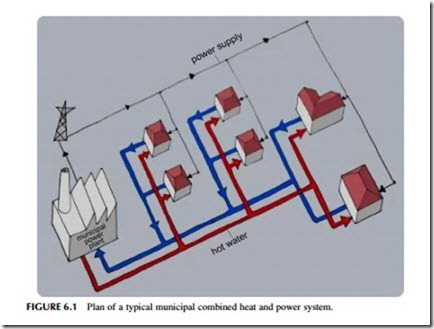COMBINED HEAT AND POWER PRINCIPLES AND APPLICATIONS
From single home heat-and-electricity units to municipal power stations sup- plying heat and power to a city, from paper mills burning their waste to provide steam and heat to large chemical plants installing gas turbine–based CHP facil- ities, CHP installations can be as different as their applications are varied. How- ever, they do share one theme. Ideally, the heat and electricity from a CHP plant will be supplied to the same users. While this is not an absolute requirement it is a pragmatic principle for a successful CHP scheme.
If the heat and power plant is supplying both types of energy to the same users, be they an industrial plant or households, then the economics of the plant will remain sound so long as the customers remain. However, if a plant supplies electricity to one customer and heat to another, it can be undermined by the loss of either. Part of this risk is mitigated if a plant can export electricity directly into the grid, but, in general, the economics of CHP will be most soundly based where the same customers take both.
Examples of how this can be achieved exist at all levels within the electricity market from the smallest electricity consumer to the largest. At the very bottom of the scale many home owners buy electricity from a utility and either use this for heating or to purchase natural gas to provide hot water for domestic use and space heating. However, it is now possible to install domestic CHP systems based on micro-turbines or fuel cells that will replace a domestic hot water sys- tem and at the same time generate electricity for use by the household, with excess power perhaps being sold to the local utility. While such systems remain costly, they are likely to become more cost effective in time.
On a larger scale a micro-turbine or a reciprocating engine burning natural gas can be used to supply both electricity and heat to an office building, a large block of apartments, or a small commercial or industrial enterprise. Such systems are widely available and can be installed in urban environments with ease. The system may be connected in such a way that excess power can be exported
to the grid, although the sizing of such systems is normally based on heat demand; power demand will be generally higher than the system can supply alone.
At the top end of the capacity scale, a municipal power plant based on a coal-fired boiler or a gas turbine can provide electricity for a city and heat for that city’s district heating system (Figure 6.1). As already noted, new systems of this type are difficult to install in existing cities but opportunities arise where major redevelopment takes place and new urban housing schemes can be built with district heating too.
In all these cases the supply of electricity is the primary requirement, but the use of heat from the power generation facility improves the economics considerably while offering significant environmental benefits. Similar opportunities exist in industry, but in many industrial cases the situation is reversed and it is heat or steam that is the primary requirement with electricity production a sec- ondary consideration. However, the same arguments apply. There are many industrial processes that require a source of heat and all industrial plants will use some electricity. Often the two can be combined to good economic effect once the benefits are recognized. So where, in the past, a paper manufacturer would have installed a boiler to supply heat while buying power from the grid, now the same manufacturer is more likely to install a CHP plant, often fired with waste produced by the paper manufacturing process. Chemical plants often require a supply of high-grade heat too, as do some refineries. Food-processing plants may require large heat supplies as well.
Such instances represent the ideal but a good match of heat and power demand is not always possible at this level. However, provided the scale is large enough, such plants may be able to install a grid-connected power plant that exports electricity while using heat generated from the same plant to supply its industrial needs. Alternatively, a large CHP plant can be built to supply an industrial site supporting a range of different industries, some with large heat requirements, others with demand for electrical power.
Domestic heat consumption remains the biggest challenge. Where district heating networks exist, a good balance between domestic heat and electricity demand is possible. But where these do not exist the only solution is either power stations meeting the electricity demand only, or domestic CHP systems. The latter are the only solution for many households but their installed base is still very small and, as already noted, cost is high. If costs can be brought down then such systems offer a real chance of a significant change in global energy usage.
